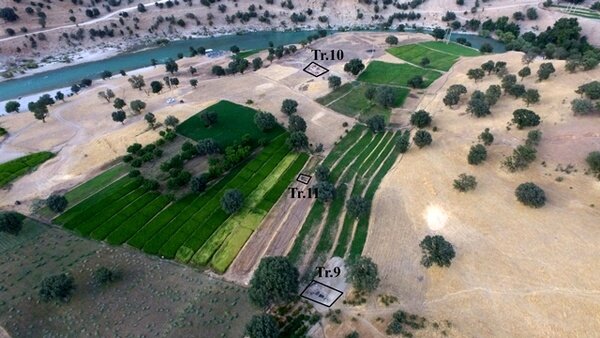A race against time: archaeologists find relics from Elamite tomb chambers

TEHRAN—A team of archaeologists has discovered arrays of burial relics from an Elamite era (c. 2700 – 539 BC) cemetery, which is now situated at the basin of a newly constructed dam in southwest Iran.
“The findings in the graves include remains of human and animal bones, clay vessels, marble vessels, soapstone vessels, bronze vessels, bronze sarees, bronze axes, bronze daggers, bronze tools, and agate beads,” ILNA quoted archaeologist Reza Naseri, who leads the survey, as saying on Saturday.
“(Radiocarbon) dating of objects, found in previous seasons of the excavation in Deh-Payin cemetery, shows dead bodies were buried in this cemetery from 2650 to 4500 years ago,” the archaeologist said.
He added, according to archaeological assessments (burial) cultural material, found on the site, dates back to the Elamite period.
“We carved five trenches to dig into the cemetery which is situated on the basin of Khersan Dam in Dena county of Kohgiluyeh- Boyer Ahmad province,” the archaeologist said.
An important feature of this cemetery, based on available evidence, revolves around cultural-commercial connections and the stylistic similarities of the art that it shares with some other areas of southeastern Iran during the third millennium BC, he explained.
In this regard, some similarities can be seen between the two in terms of marbles, metal vessels, and especially soapstone objects, Naseri said.
Situated in a region situated in the modern-day provinces of Ilam and Khuzestan, Elam was one of the most impressive civilizations of the ancient world. It was never a cohesive ethnic kingdom or polity but rather a federation of different tribes governed at various times by cities such as Susa, Anshan, and Shimashki until it was united during the Middle Elamite Period, briefly, as an empire.
The name Elam was given to the region by others–the Akkadians and Sumerians of Mesopotamia –and is thought to be their version of what the Elamites called themselves– Haltami (or Haltamti)–meaning “those of the high country.” 'Elam', therefore, is usually translated to mean “highlands” or “high country” as it comprised settlements on the Iranian Plateau that stretched from the southern plains to the elevations of the Zagros Mountains.
Susa was once the capital of the Elamite Empire and later the administrative capital of the Achaemenian king Darius I and his successors from 522 BC. Throughout the late prehistoric periods, Elam was closely tied culturally to Mesopotamia. Later, perhaps because of domination by the Akkadian dynasty (c. 2334–c. 2154 BC), Elamites adopted the Sumero-Akkadian cuneiform script.
According to Britannica, the earliest Elamite writings are in a figurative or pictographic script and date from the middle of the 3rd millennium BC.
Documents from the second period, which lasted from the 16th to the 8th century BC, are written in cuneiform; the stage of the language found in these documents is sometimes called Old Elamite. The last period of Elamite texts is that of the reign of the Achaemenian kings of Persia (6th to 4th century BC), who used Elamite, along with Akkadian and Old Persian, in their inscriptions. The language of this period, also written in the cuneiform script, is often called New Elamite.
Although all three stages of Elamite have not been completely deciphered, several grammatical features of the language are known to scholars. These include a plural formation using the suffix -p, the personal pronouns, and the endings of several verb forms.
From the Caspian Sea in the northwest to Balochestan in the southeast, the Iranian plateau stretches nearly 2,000 km. It encompasses the greater part of Iran, Afghanistan, and Pakistan west of the Indus River, containing some 3,700,000 square kilometers. Despite being called a “plateau”, it is far from flat but contains several mountain ranges, the highest peak being Damavand in the Alborz mountain range at 5610 m, and the Dasht-e Loot east of Kerman in Central Iran, falling below 300 m.
The earliest well-documented evidence of human habitation is found in the deposits of several excavated caves and rock shelters, located mainly in the Zagros Mountains of western Iran and dated to Middle Paleolithic or Mousterian times (c. 100,000 BC). A 2019 study published by the Journal of Human Evolution suggests that Neanderthals were roaming over the Iranian Zagros mountain range between 40 to 70 thousand years ago. Neanderthals lived before and during the last Ice Age of the Pleistocene in some of the most unforgiving environments ever inhabited by humans. They developed a successful culture, with a complex stone tool technology, that was based on hunting, some scavenging, and local plant collection. Their survival during tens of thousands of years of the last glaciation is a remarkable testament to human adaptation.
AM
